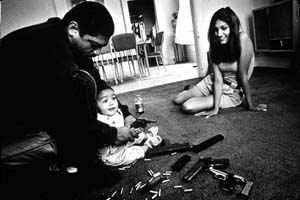|
GANG LIFE IN EAST L.A.
by Joseph Rodríguez

I see Los Angeles as a post-modern Wild West where everyone has
a gun and they use it. It is an uncontrolled and slightly scary
place, a land of dreams and beauty, playing by its own rules.
My aim in photographing gang life in Los Angeles has been to get
to the core of violence in America, not just the physical violence
against one another, but the quiet violence of letting families
fall apart, the violence of segregation and isolation.
La vida loca, or the crazy life, is what they call the barrio
gang experience. This lifestyle originated with the Mexican Pachuco
gangs of the 1930s and 1940s whose own style and language in the
barrios of America was linked to the urban youth style of major
Mexican cities, and was later recreated with the Cholos (a term
meaning "low life," appropriated by Chicano barrio youth to describe
the style and people associated with local gang make-up). It became
the main model and influence for outlaw bikers of the 1950s and
1960s, the L.A. punk/rock scene in the 1970s and 1980s, and the
Crips and Bloods of the 1980s and 1990s. As Leon Bing commented
in her 1991 book Do or Die (Harper Collins): "It was the cholo
homeboy who first walked the walk and talked the talk. It was
the Mexican American Pachuco who initiated the emblematic tattoos
the signing with hands, the writing legends on the wall."
Although there have been truces among many of the gangs since
theriots of 1992, many gang wars still continue. East L.A. has
long been a neglected neighborhood with a predominately Mexican
population. It has one of the nation's highest drop out rates
from schools, youth unemployment hovers around seventy-five percent
in the most neglected areas, and teenage pregnancy is at an all
time high in this community. There is an aspect of suicide among
many of these gang kids (between ten and twenty-one years old)
whose options have been cut off-no education, no work, and no
opportunities for advancement. They stand on street corners and
parks, flashing gang signs, inviting bullets. Its either la torcida
(prison) or death: a warrior's path when even self-preservation
is not at stake. And if they murder, the victims are usually the
ones who look like them, the ones closest to who they are-their
mirror reflections. They murder and they're killing themselves,
over and over.
Joseph Rodríguez
Joseph Rodríguez can be reached at:
rodrigj@earthlink.net
Excerpts from Rodriguez's journals,
written while living in Los Angeles, 1992-94
[ We recommend for your comfort, that you save to your computer the
following extended essay by Ruben Martinez]
These photographs are published in the book East Side Stories:Gang
Life in East L.A., by powerHouse Books, New York, November, 1996. East
Side Stories also includes an essay by Rubén
Martínez, author of The Other Side: Notes from the New L.A.,
Mexico City and Beyond (Vintage), and an interview with Luis J. Rodríguez,author
of Always Running, La Vida Loca: Gang Days in L.A. (Touchstone, Simon
& Schuster). Contact the publisher for more information at 212-982-3154,
or e-mail at phcultent@aol.com.
|


